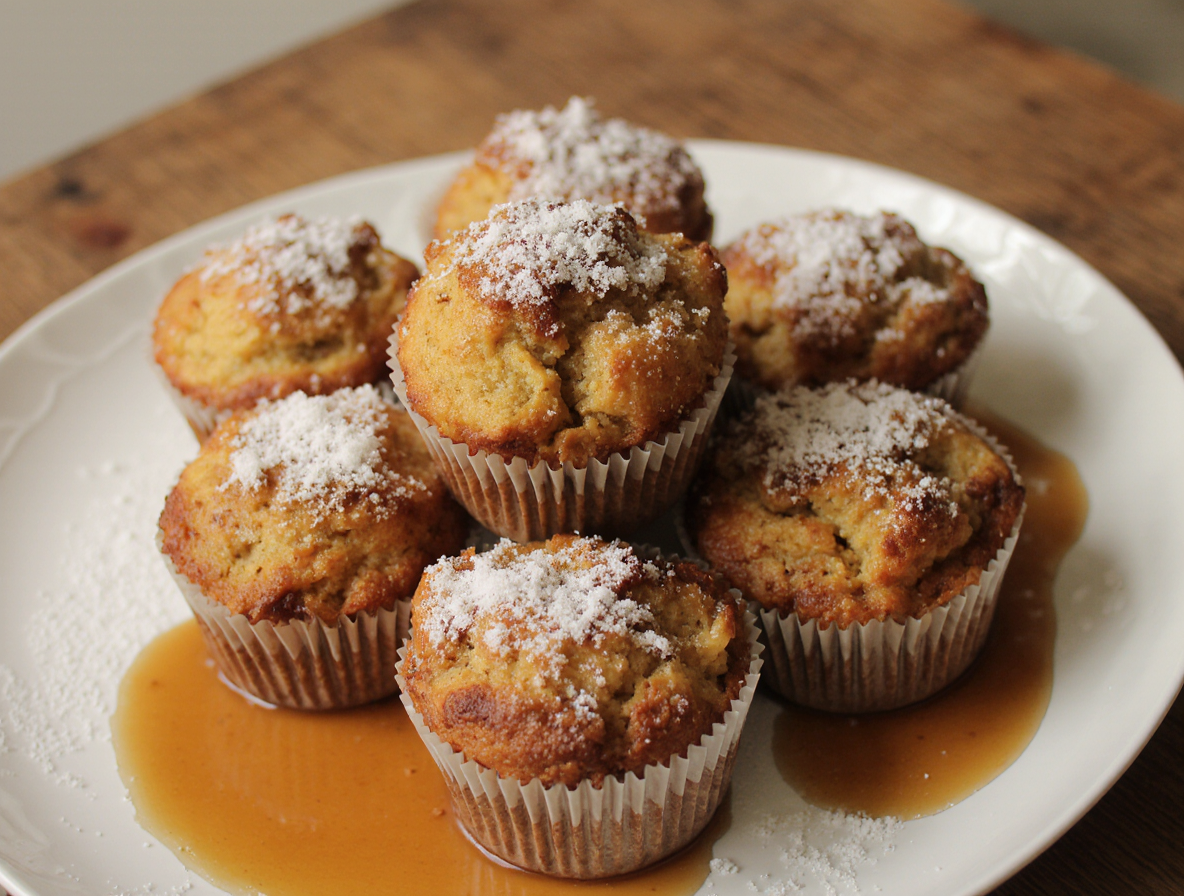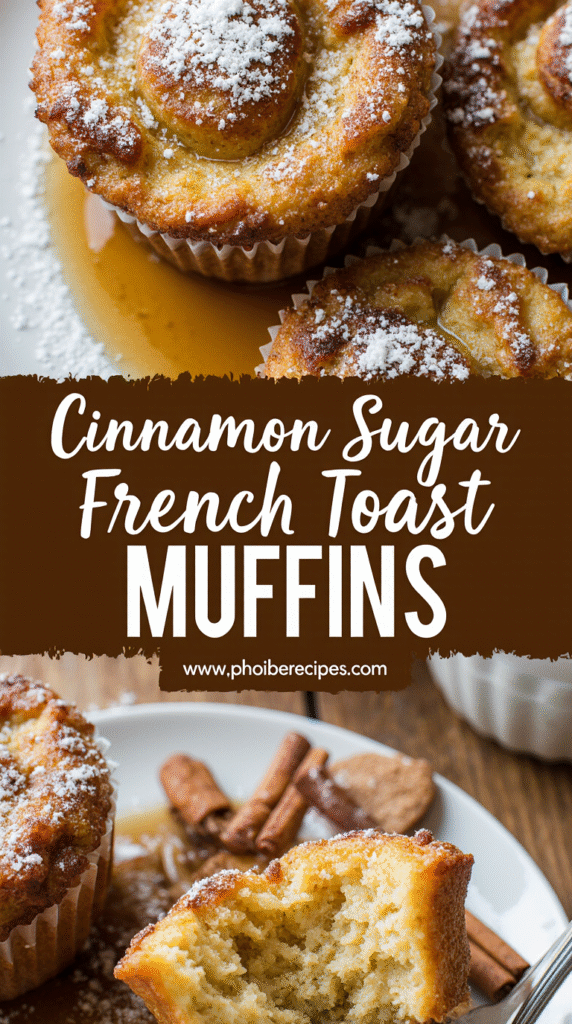The Secret to Perfect Cinnamon Toast Muffins (Tested 50+ Times)
Cinnamon toast muffins quickly became my absolute favorite breakfast creation after testing the recipe more than 50 times to get it just right. These tasty little breakfast beauties combine the sweet, comforting flavors of classic French toast with the convenience of a grab-and-go muffin. What started as a simple experiment has turned into my signature dish that takes just 35 minutes to prepare with only 6 basic ingredients.
I’ve perfected these cinnamon sugar french toast muffins through countless batches, and the french toast muffins recipe I’m sharing today captures all those cozy weekend breakfast flavors in a portable form that’s perfect for busy mornings. The magic happens when you let these cinnamon french toast muffins cool just until you can handle them, then dip them in butter and cinnamon sugar to create the perfect crispy topping. Whether you enjoy these easy cinnamon toast muffins on their own or dress them up with whipped cream or maple syrup for a truly decadent experience, I’ll show you exactly how to achieve muffin perfection every single time.
What Makes Cinnamon Toast Muffins So Addictive
The allure of cinnamon toast muffins lies in their irresistible combination of textures, flavors, and convenience. After countless batches, I’ve discovered exactly what makes these breakfast treats impossible to resist.
The perfect balance of soft and crisp
These delightful muffins capture a magical textural contrast that keeps you coming back for more. Unlike traditional French toast, which can sometimes be uniformly soft, the muffin tin creates perfectly crisp edges while maintaining a tender, chewy interior. This happens because all the edges get exposed to direct heat, creating that delightful contrast. The thicker bread ensures the muffins retain a lovely, chewy texture without becoming soggy.
Furthermore, the finishing touch of dipping the warm tops in melted butter and cinnamon sugar creates an addictive crunchy coating that mimics the caramelized exterior of the best cinnamon toast. This crispy-meets-soft texture profile stimulates multiple sensory experiences in each bite.
Why cinnamon sugar works so well
The cinnamon-sugar combination creates a flavor profile that’s both comforting and complex. Specifically, this classic pairing works because:
- It creates an aromatic experience that fills your kitchen with a “cinnamon-sugar heaven” scent
- The spicy warmth of cinnamon balances perfectly with sweet sugar
- The flavor duo provides both immediate sweetness and lingering spice notes
The cinnamon sugar coating isn’t just about flavor—it serves a practical purpose too. As one expert notes, “Sugar is hygroscopic and attracts moisture from the air which is why baked goods with more sugar in them stay moister for longer”. This means your cinnamon toast muffins remain fresh and delicious even days after baking.
How muffin form changes the game
Transforming French toast into muffin form revolutionizes this breakfast classic. First and foremost, the muffin format makes breakfast portable—perfect for busy mornings when you need to eat on the go. Additionally, these muffins freeze beautifully, allowing you to make a batch ahead and reheat individual portions whenever cravings strike.
The muffin format also eliminates the need for flipping and babysitting traditional French toast on a griddle. As one baker explains, “You skip all the dipping, frying, and flipping commonly required for French toast”. In essence, the muffin tin does the work for you, creating consistent results every time.
The portability factor cannot be overstated. These convenient breakfast bites can be enjoyed anywhere—from packed lunches to car rides or cozy mornings on the couch. This versatility makes cinnamon toast muffins not just a delicious treat but a practical solution for busy households.
Essential Ingredients and Why They Matter
After testing dozens of batches, I’ve identified the critical ingredients that make these cinnamon toast muffins truly special. Each component plays a specific role in creating that perfect balance of flavor and texture.
Choosing the right bread: texture and thickness
For truly exceptional cinnamon toast muffins, the bread selection matters tremendously. Brioche, challah, and French baguette create the best foundation due to their sturdy structure. These denser breads absorb the custard mixture without falling apart. Slightly stale bread works better since it readily soaks up more liquid without becoming mushy. If using fresh bread, I recommend spreading the cubes on a baking sheet to air-dry for about an hour before preparing your muffins.
Eggs, milk, and vanilla: the custard base
Eggs provide structure, moisture, and richness to the custard mixture. They act as binding agents, creating that velvety texture we love. For milk, whole milk delivers the creamiest results, although any variety works. Non-dairy alternatives like almond milk offer excellent substitutes for those avoiding dairy. A splash of vanilla extract enhances the overall flavor profile, complementing both the bread and spices perfectly.
Cinnamon and sugar: the flavor duo
The ideal cinnamon-to-sugar ratio is 1:4—meaning one part cinnamon to four parts sugar. This creates the perfect balance of warmth without overwhelming sweetness. For added dimension, consider mixing granulated white sugar with brown sugar. Some bakers even add a pinch of nutmeg or cardamom to elevate the classic cinnamon profile.
Butter vs. oil: which gives better texture?
Through extensive testing, I’ve found that butter delivers superior flavor and creates a delightful melt-in-your-mouth quality. Muffins made with butter have richer taste and crisper tops. Meanwhile, oil produces a lighter, fluffier texture. For recipes without strong competing flavors, butter remains my top choice for these muffins.
Optional add-ins: berries, nuts, or chocolate?
Transform your basic cinnamon toast muffins by incorporating:
- Fresh fruits like blueberries, diced apples, or sliced bananas
- Chopped nuts such as pecans or walnuts for delightful crunch
- Mini chocolate chips for indulgent sweetness
- Raisins or dried cranberries for chewy texture
Step-by-Step: How to Make Cinnamon Toast Muffins
Making perfect cinnamon toast muffins is remarkably straightforward once you know the essential steps. Through my many test batches, I’ve refined this process to ensure consistent, delicious results every time.
1. Prep your muffin tin and oven
First, preheat your oven to 350°F. This moderate temperature allows the muffins to cook evenly throughout. Generously grease a standard 12-cup muffin tin with melted butter using a silicone brush for best results. Alternatively, a light coating of cooking spray works well. For easier removal, you might prefer paper liners, though the crispy edges develop better with direct contact to the greased pan.
2. Soak the bread cubes evenly
In a large mixing bowl, whisk together eggs, milk, sugar, vanilla extract, and cinnamon until well combined. Cut your bread into uniform 1/2-inch cubes – keeping them consistent ensures even soaking. Gently fold the bread cubes into the custard mixture, making sure each piece gets fully coated. Allow the mixture to rest for about 20-30 minutes, occasionally stirring to ensure even absorption.
3. Fill and pack the muffin cups
Once soaked, use a 3-tablespoon cookie scoop to divide the mixture evenly among the muffin cups. Fill each cup about 3/4 full, allowing space for the muffins to rise slightly. Lightly press down on the bread mixture to compact it – don’t be afraid to let some pieces extend above the pan for extra texture and height.
4. Bake until golden and set
Place the muffin tin in the preheated oven and bake for 20-25 minutes. Your kitchen will soon smell like “cinnamon-sugar heaven.” The muffins are done when the tops are golden brown, they spring back when lightly touched, and a toothpick inserted in the center comes out clean. The tops should no longer jiggle when gently shaken.
5. Dip in cinnamon sugar while warm
Let the muffins cool in the pan for about 5 minutes. Meanwhile, prepare the cinnamon sugar coating by mixing sugar and cinnamon in a small bowl (use a 4:1 ratio). Melt some butter in another bowl. Dip the still-warm muffin tops first into the melted butter, then immediately into the cinnamon sugar mixture. This creates that irresistible crispy, sweet topping that makes these muffins truly special.
Tips from 50+ Test Batches
Through years of testing these delicious treats, I’ve encountered every possible issue with cinnamon toast muffins. My kitchen experiments have yielded valuable lessons that I’m excited to share with you.
Avoiding soggy centers
French toast muffins naturally tend toward moisture in the center. To prevent mushiness, use day-old or slightly stale bread that absorbs the custard without becoming waterlogged. If your bread is fresh, spread the cubes on a baking sheet and air-dry for about an hour before mixing. First and foremost, ensure you’re using enough bread—9 to 10 cups of cubed bread is ideal for proper absorption. Finally, avoid over-mixing the bread with the custard as this can lead to sogginess.
Getting the topping to stick
Timing is everything! Let the muffins cool in the pan for exactly 5 minutes before applying the topping. The residual warmth helps the melted butter and cinnamon sugar adhere perfectly. For the ideal cinnamon sugar ratio, use a 4-to-1 mix (1 cup sugar to ¼ cup cinnamon). Consequently, this creates that irresistible crispy coating that mimics traditional cinnamon toast.
How to make them ahead and reheat
These muffins are perfect for prepping ahead. You can prepare them the day before—cube the bread, let it dry overnight, and mix the custard separately. Alternatively, bake the entire batch and store for quick breakfasts. When reheating refrigerated muffins, warm them in a 350°F oven for 7-10 minutes or microwave for 15-30 seconds.
Best way to freeze and store
For room temperature storage, place in an airtight container with paper towels on the bottom and top to absorb moisture—this prevents sogginess. They’ll last 3 days at room temperature or 5 days refrigerated. To freeze, wrap individually in plastic wrap or flash freeze on a baking sheet before transferring to a freezer bag. Frozen muffins remain good for up to 3 months.
Common mistakes and how to fix them
Most commonly, bakers struggle with:
- Dry muffins: Fix by drizzling melted butter over the tops
- Overmixing: Stir just until combined to maintain light texture
- Underbaking: Reduce oven temperature and increase baking time slightly if centers remain raw
Conclusion
Cinnamon toast muffins stand as my proudest kitchen creation after 50+ test batches and countless mornings perfecting them. Throughout this journey, we’ve explored why these breakfast treats work so well—from their perfect textural balance to the science behind that irresistible cinnamon-sugar coating. The beauty of these muffins lies not only in their delicious taste but also in their practicality for busy mornings.
Making these delightful treats requires attention to detail, certainly, but the process remains surprisingly simple. Choosing the right bread creates the foundation, while the perfect custard mixture transforms ordinary ingredients into something magical. Undoubtedly, the final dip in butter and cinnamon sugar elevates these muffins from good to unforgettable.
My experience has taught me that small adjustments make significant differences. Day-old bread prevents sogginess, proper timing helps the topping stick perfectly, and careful storage keeps them fresh for days. You might encounter challenges during your first attempt, though following the tips shared from my many test batches will help you achieve perfect results.
Therefore, I encourage you to try these cinnamon toast muffins yourself. They combine the nostalgic comfort of traditional cinnamon toast with modern convenience—ready whenever cravings strike. Whether enjoyed fresh from the oven on lazy weekend mornings or grabbed on hectic weekdays, these muffins deliver that perfect bite every time. After all, the best recipes come from persistence, passion, and plenty of taste-testing along the way.
FAQs
Q1. How long do cinnamon toast muffins stay fresh? Cinnamon toast muffins can be stored at room temperature for up to 3 days or refrigerated for up to 5 days when kept in an airtight container. For longer storage, you can freeze them for up to 3 months.
Q2. What’s the secret to avoiding soggy centers in cinnamon toast muffins? The key to avoiding soggy centers is using day-old or slightly stale bread, which absorbs the custard mixture better without becoming waterlogged. If using fresh bread, spread the cubes on a baking sheet to air-dry for about an hour before mixing.
Q3. Can I make cinnamon toast muffins ahead of time? Yes, you can prepare cinnamon toast muffins ahead of time. You can cube the bread and let it dry overnight, then mix the custard separately the next day. Alternatively, you can bake the entire batch and store them for quick breakfasts throughout the week.
Q4. What’s the best way to reheat cinnamon toast muffins? To reheat refrigerated cinnamon toast muffins, warm them in a 350°F oven for 7-10 minutes or microwave for 15-30 seconds. If frozen, thaw them overnight in the refrigerator before reheating.
Q5. Can I add other ingredients to cinnamon toast muffins? Absolutely! You can customize your cinnamon toast muffins by adding fresh fruits like blueberries or diced apples, chopped nuts such as pecans or walnuts for crunch, mini chocolate chips for extra sweetness, or dried fruits like raisins or cranberries for a chewy texture.


